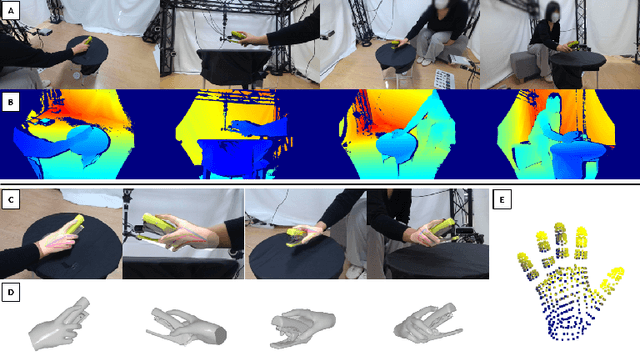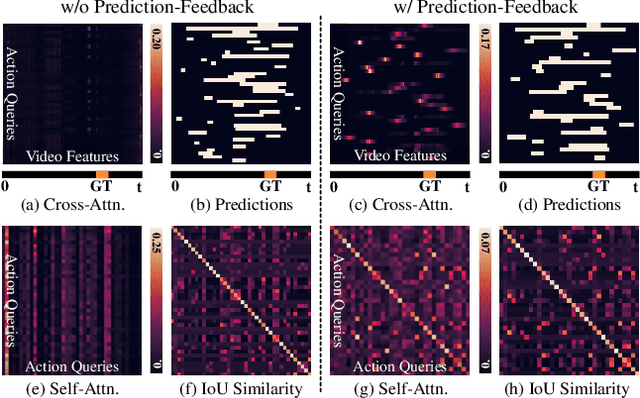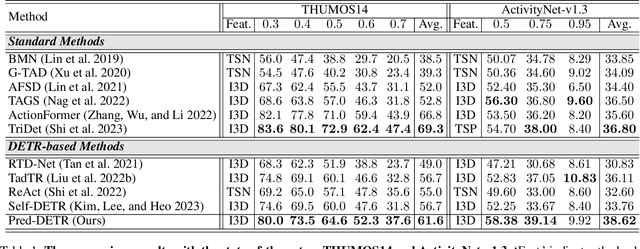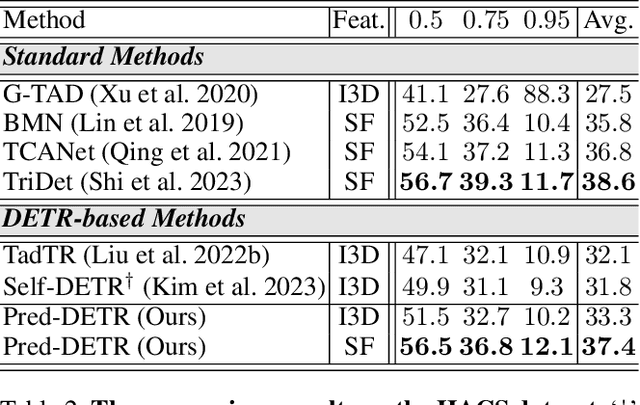Jihyun Lee
MPMAvatar: Learning 3D Gaussian Avatars with Accurate and Robust Physics-Based Dynamics
Oct 02, 2025Abstract:While there has been significant progress in the field of 3D avatar creation from visual observations, modeling physically plausible dynamics of humans with loose garments remains a challenging problem. Although a few existing works address this problem by leveraging physical simulation, they suffer from limited accuracy or robustness to novel animation inputs. In this work, we present MPMAvatar, a framework for creating 3D human avatars from multi-view videos that supports highly realistic, robust animation, as well as photorealistic rendering from free viewpoints. For accurate and robust dynamics modeling, our key idea is to use a Material Point Method-based simulator, which we carefully tailor to model garments with complex deformations and contact with the underlying body by incorporating an anisotropic constitutive model and a novel collision handling algorithm. We combine this dynamics modeling scheme with our canonical avatar that can be rendered using 3D Gaussian Splatting with quasi-shadowing, enabling high-fidelity rendering for physically realistic animations. In our experiments, we demonstrate that MPMAvatar significantly outperforms the existing state-of-the-art physics-based avatar in terms of (1) dynamics modeling accuracy, (2) rendering accuracy, and (3) robustness and efficiency. Additionally, we present a novel application in which our avatar generalizes to unseen interactions in a zero-shot manner-which was not achievable with previous learning-based methods due to their limited simulation generalizability. Our project page is at: https://KAISTChangmin.github.io/MPMAvatar/
Affordance-Guided Diffusion Prior for 3D Hand Reconstruction
Oct 01, 2025Abstract:How can we reconstruct 3D hand poses when large portions of the hand are heavily occluded by itself or by objects? Humans often resolve such ambiguities by leveraging contextual knowledge -- such as affordances, where an object's shape and function suggest how the object is typically grasped. Inspired by this observation, we propose a generative prior for hand pose refinement guided by affordance-aware textual descriptions of hand-object interactions (HOI). Our method employs a diffusion-based generative model that learns the distribution of plausible hand poses conditioned on affordance descriptions, which are inferred from a large vision-language model (VLM). This enables the refinement of occluded regions into more accurate and functionally coherent hand poses. Extensive experiments on HOGraspNet, a 3D hand-affordance dataset with severe occlusions, demonstrate that our affordance-guided refinement significantly improves hand pose estimation over both recent regression methods and diffusion-based refinement lacking contextual reasoning.
PicPersona-TOD : A Dataset for Personalizing Utterance Style in Task-Oriented Dialogue with Image Persona
Apr 24, 2025Abstract:Task-Oriented Dialogue (TOD) systems are designed to fulfill user requests through natural language interactions, yet existing systems often produce generic, monotonic responses that lack individuality and fail to adapt to users' personal attributes. To address this, we introduce PicPersona-TOD, a novel dataset that incorporates user images as part of the persona, enabling personalized responses tailored to user-specific factors such as age or emotional context. This is facilitated by first impressions, dialogue policy-guided prompting, and the use of external knowledge to reduce hallucinations. Human evaluations confirm that our dataset enhances user experience, with personalized responses contributing to a more engaging interaction. Additionally, we introduce a new NLG model, Pictor, which not only personalizes responses, but also demonstrates robust performance across unseen domains https://github.com/JihyunLee1/PicPersona.
Mirror: Multimodal Cognitive Reframing Therapy for Rolling with Resistance
Apr 16, 2025Abstract:Recent studies have explored the use of large language models (LLMs) in psychotherapy; however, text-based cognitive behavioral therapy (CBT) models often struggle with client resistance, which can weaken therapeutic alliance. To address this, we propose a multimodal approach that incorporates nonverbal cues, allowing the AI therapist to better align its responses with the client's negative emotional state. Specifically, we introduce a new synthetic dataset, Multimodal Interactive Rolling with Resistance (Mirror), which is a novel synthetic dataset that pairs client statements with corresponding facial images. Using this dataset, we train baseline Vision-Language Models (VLMs) that can analyze facial cues, infer emotions, and generate empathetic responses to effectively manage resistance. They are then evaluated in terms of both the therapist's counseling skills and the strength of the therapeutic alliance in the presence of client resistance. Our results demonstrate that Mirror significantly enhances the AI therapist's ability to handle resistance, which outperforms existing text-based CBT approaches.
REWIND: Real-Time Egocentric Whole-Body Motion Diffusion with Exemplar-Based Identity Conditioning
Apr 08, 2025Abstract:We present REWIND (Real-Time Egocentric Whole-Body Motion Diffusion), a one-step diffusion model for real-time, high-fidelity human motion estimation from egocentric image inputs. While an existing method for egocentric whole-body (i.e., body and hands) motion estimation is non-real-time and acausal due to diffusion-based iterative motion refinement to capture correlations between body and hand poses, REWIND operates in a fully causal and real-time manner. To enable real-time inference, we introduce (1) cascaded body-hand denoising diffusion, which effectively models the correlation between egocentric body and hand motions in a fast, feed-forward manner, and (2) diffusion distillation, which enables high-quality motion estimation with a single denoising step. Our denoising diffusion model is based on a modified Transformer architecture, designed to causally model output motions while enhancing generalizability to unseen motion lengths. Additionally, REWIND optionally supports identity-conditioned motion estimation when identity prior is available. To this end, we propose a novel identity conditioning method based on a small set of pose exemplars of the target identity, which further enhances motion estimation quality. Through extensive experiments, we demonstrate that REWIND significantly outperforms the existing baselines both with and without exemplar-based identity conditioning.
ORIGEN: Zero-Shot 3D Orientation Grounding in Text-to-Image Generation
Mar 28, 2025Abstract:We introduce ORIGEN, the first zero-shot method for 3D orientation grounding in text-to-image generation across multiple objects and diverse categories. While previous work on spatial grounding in image generation has mainly focused on 2D positioning, it lacks control over 3D orientation. To address this, we propose a reward-guided sampling approach using a pretrained discriminative model for 3D orientation estimation and a one-step text-to-image generative flow model. While gradient-ascent-based optimization is a natural choice for reward-based guidance, it struggles to maintain image realism. Instead, we adopt a sampling-based approach using Langevin dynamics, which extends gradient ascent by simply injecting random noise--requiring just a single additional line of code. Additionally, we introduce adaptive time rescaling based on the reward function to accelerate convergence. Our experiments show that ORIGEN outperforms both training-based and test-time guidance methods across quantitative metrics and user studies.
Keyword-Aware ASR Error Augmentation for Robust Dialogue State Tracking
Sep 10, 2024



Abstract:Dialogue State Tracking (DST) is a key part of task-oriented dialogue systems, identifying important information in conversations. However, its accuracy drops significantly in spoken dialogue environments due to named entity errors from Automatic Speech Recognition (ASR) systems. We introduce a simple yet effective data augmentation method that targets those entities to improve the robustness of DST model. Our novel method can control the placement of errors using keyword-highlighted prompts while introducing phonetically similar errors. As a result, our method generated sufficient error patterns on keywords, leading to improved accuracy in noised and low-accuracy ASR environments.
Inference is All You Need: Self Example Retriever for Cross-domain Dialogue State Tracking with ChatGPT
Sep 10, 2024Abstract:Traditional dialogue state tracking approaches heavily rely on extensive training data and handcrafted features, limiting their scalability and adaptability to new domains. In this paper, we propose a novel method that leverages inference and in-context learning with ChatGPT for domain transfer in dialogue state tracking, without any parameter updates. By guiding ChatGPT's chain of thought, we enable it to retrieve relevant examples and generalize knowledge to accurately infer dialogue states, solely through inference. Experimental results on the MultiWOZ dataset demonstrate competitive performance and promising generalization across domains. Our parameter-free approach offers a scalable and adaptable solution, opening new research directions in domain transfer learning.
Dense Hand-Object(HO) GraspNet with Full Grasping Taxonomy and Dynamics
Sep 06, 2024



Abstract:Existing datasets for 3D hand-object interaction are limited either in the data cardinality, data variations in interaction scenarios, or the quality of annotations. In this work, we present a comprehensive new training dataset for hand-object interaction called HOGraspNet. It is the only real dataset that captures full grasp taxonomies, providing grasp annotation and wide intraclass variations. Using grasp taxonomies as atomic actions, their space and time combinatorial can represent complex hand activities around objects. We select 22 rigid objects from the YCB dataset and 8 other compound objects using shape and size taxonomies, ensuring coverage of all hand grasp configurations. The dataset includes diverse hand shapes from 99 participants aged 10 to 74, continuous video frames, and a 1.5M RGB-Depth of sparse frames with annotations. It offers labels for 3D hand and object meshes, 3D keypoints, contact maps, and \emph{grasp labels}. Accurate hand and object 3D meshes are obtained by fitting the hand parametric model (MANO) and the hand implicit function (HALO) to multi-view RGBD frames, with the MoCap system only for objects. Note that HALO fitting does not require any parameter tuning, enabling scalability to the dataset's size with comparable accuracy to MANO. We evaluate HOGraspNet on relevant tasks: grasp classification and 3D hand pose estimation. The result shows performance variations based on grasp type and object class, indicating the potential importance of the interaction space captured by our dataset. The provided data aims at learning universal shape priors or foundation models for 3D hand-object interaction. Our dataset and code are available at https://hograspnet2024.github.io/.
Prediction-Feedback DETR for Temporal Action Detection
Aug 29, 2024



Abstract:Temporal Action Detection (TAD) is fundamental yet challenging for real-world video applications. Leveraging the unique benefits of transformers, various DETR-based approaches have been adopted in TAD. However, it has recently been identified that the attention collapse in self-attention causes the performance degradation of DETR for TAD. Building upon previous research, this paper newly addresses the attention collapse problem in cross-attention within DETR-based TAD methods. Moreover, our findings reveal that cross-attention exhibits patterns distinct from predictions, indicating a short-cut phenomenon. To resolve this, we propose a new framework, Prediction-Feedback DETR (Pred-DETR), which utilizes predictions to restore the collapse and align the cross- and self-attention with predictions. Specifically, we devise novel prediction-feedback objectives using guidance from the relations of the predictions. As a result, Pred-DETR significantly alleviates the collapse and achieves state-of-the-art performance among DETR-based methods on various challenging benchmarks including THUMOS14, ActivityNet-v1.3, HACS, and FineAction.
 Add to Chrome
Add to Chrome Add to Firefox
Add to Firefox Add to Edge
Add to Edge